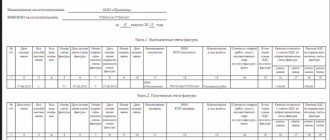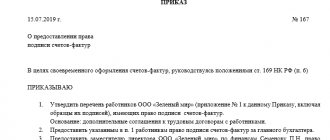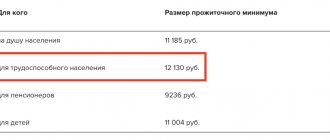What are invoices for: basic knowledge
An invoice is a documentary basis for the buyer to accept the VAT amounts presented by the seller for deduction (refund). This follows from paragraph 1 of Article 169 of the Tax Code of the Russian Federation. Tax legislation requires an invoice to be issued every time you sell goods, work, services or property rights. Invoices can be generated on paper or electronically. The paper form and the rules for filling it out are defined in Appendix No. 1 to Decree of the Government of the Russian Federation of December 26, 2011 No. 1137.
Decree of the Government of the Russian Federation dated December 26, 2011 No. 1137 approved the current forms and Rules for filling out (maintaining) the following documents used in VAT calculations:
- invoices (Appendix No. 1);
- adjustment invoice (Appendix No. 2);
- log of received and issued invoices (Appendix No. 3);
- purchase books (Appendix No. 4);
- sales books (Appendix No. 5).
If the seller wishes to send invoices to buyers electronically, the buyer is required to agree to this. At the same time, the means of receiving, exchanging and processing invoices electronically between the seller and the buyer must be compatible. They must comply with the established formats (paragraph 2, paragraph 1, article 169 of the Tax Code of the Russian Federation). Invoices are issued and received electronically in the manner approved by Order of the Ministry of Finance of Russia dated November 10, 2015 No. 174n.
Address on invoice
From the literal interpretation of the provisions of paragraphs. “g”, “k” clause 1 of the Rules, it is logical to assume that information about the address of the seller and buyer is indicated in the invoice in strict accordance with the data reflected in the Unified State Register of Legal Entities. Any assumptions or features of filling out this detail (including the structure and order of reflection of address elements) are not established by the Rules.
At the same time, the Tax Code of the Russian Federation does not regulate either the procedure for assigning (or indicating) an address, or the procedure for making entries in the Unified State Register of Legal Entities (USRIP), nor does it disclose the content of the concept “address” (see also letter of the Ministry of Finance of Russia dated January 28, 2015 No. 03-07-09 /2992).
In accordance with paragraph 1 of Art. 2 of the Federal Law of December 28, 2013 No. 443-FZ “On the Federal Information Address System and on Amendments to the Federal Law “On General Principles of the Organization of Local Self-Government in the Russian Federation” (hereinafter referred to as Law No. 443-FZ), the address is understood as a description of the location object of address, structured in accordance with the principles of organizing local self-government in the Russian Federation and including, among other things, the name of an element of the planning structure (if necessary), an element of the road network, as well as a digital and (or) alphanumeric designation of the object of address, allowing identify him.
According to clause 2 of the Rules for assignment, change and cancellation of addresses, approved in pursuance of clause 4, part 1, art. 5 of Law No. 443-FZ, by Decree of the Government of the Russian Federation of November 19, 2014 No. 1221 (hereinafter referred to as Rules No. 1221), address-forming elements include the country, subject of the Russian Federation, municipality, settlement, element of the road network, element of the planning structure and identification element (elements) of the addressing object.
In pursuance of clause 52 of Rules No. 1221, by order of the Ministry of Finance of Russia dated November 5, 2015 No. 171n, the Rules for the abbreviated name of address-forming elements (hereinafter referred to as the Abbreviation Rules) were approved. Clause 3 of this document provides that when writing the names of address-forming elements in Russian, abbreviated names of republics, territories, regions, federal cities, autonomous regions, autonomous districts, municipalities, settlements, elements of the planning structure, elements of the road network, are used. identification elements of the addressing object given in the Appendix to the specified document. At the same time, the names of address-forming elements are not abbreviated only in the case when the decoding of such an abbreviation leads to a different understanding of its name (clause 5 of the Abbreviation Rules, see also clause 4.8 of the National Standard of the Russian Federation GOST R 7.0.12-2011 “SIBID. Bibliographic record ". Abbreviation of words and phrases in Russian. General requirements and rules."
Taking into account the above, we consider it acceptable to fill out lines 2a and 6a of the invoice from 10/01/2017 using generally accepted abbreviations of address-forming elements in accordance with the Appendix to the Abbreviation Rules (for example: city - “city”, street - “street.”).
As an additional argument to the above, we can cite the letter of the Ministry of Finance of Russia dated October 11, 2017 No. 03-07-09/66329, where, in response to the taxpayer’s question about the need to indicate the seller’s address in capital letters from October 1, 2017, in invoices for the sale of goods, works or services and taking into account the abbreviations applied to the components of the organization’s address in the Unified State Register of Legal Entities, specialists from the financial department responded that the indication in the invoice of the abbreviated address of the seller, indicated in the Unified State Register of Legal Entities partly in capital letters and partly in capital letters, is not a basis for recognizing the invoice drawn up in violation of the established order.
In the letter of the Ministry of Finance of Russia dated November 9, 2009 No. 03-07-09/57, the opinion was also expressed that invoices in which the addresses of the seller and buyer are indicated with abbreviated words, but with full indication of the components of the address (postal code, city name, street etc.) are not compiled in violation of the established procedure. In our opinion, as of October 1, 2017, the above explanations have not lost their relevance.
In this regard, even if the above procedure for filling out the “Address” details of an invoice is recognized (i.e. without literally following the format for writing the address used in the Unified State Register of Legal Entities) as erroneous, the taxpayer-buyer faces risks associated with the application of VAT deductions for the corresponding invoices, we do not see. It is obvious that these errors (if the use of generally accepted abbreviations of address-forming elements and the use of lowercase letters are considered an error) do not prevent the identification of the seller and the buyer, and even more so the name of the goods (works, services, property rights), their value, rate and amount of VAT charged to the buyer .
Another change to the invoice form
The last time the invoice form changed was relatively recently - from July 1, 2021. By Decree of the Government of the Russian Federation dated May 25, 2017 No. 625, changes were made to the forms of invoices and adjustment invoices. From July 1, 2021, the invoice form was supplemented with line 8 “Identifier of the government contract, agreement (agreement).” The adjustment invoice, in turn, was supplemented with a new line 5 with the same name. We talked about this in detail in the article “Invoice from July 1, 2021: new form and format.”
As of October 1, 2021, the invoice form has changed again. Now the amendments are provided for by Decree of the Government of the Russian Federation dated August 19, 2017 No. 981. You can download this document from the link.
Invoice form from July 1, 2021
Law No. 56-FZ dated April 3, 2017 introduced additional requirements for information included in invoices. Appendix No. 1 of Decree of the Government of the Russian Federation dated December 26, 2011 No. 1137 (as amended on May 25, 2017) contains its amended form and rules for filling it out, and Appendix No. 2 presents the updated form of the adjustment invoice.
Has much changed in the current forms? In fact, there is only one innovation: a line was added to both forms in which the identifier of the government contract for the performance of work, provision of services or supply of goods, as well as contracts or agreements on subsidies, investments from the budget, or contributions to the authorized capital, if any, should now be indicated place. Line 8 has become new for the invoice, and line 5 for the adjustment document.
Invoices are issued not only in paper form, but also electronically. The new invoice from July 1, 2021 is drawn up, as before, in accordance with paragraphs. 5 and 6 tbsp. 169 of the Tax Code of the Russian Federation and the Rules for filling out invoices (Resolution No. 1137 as amended on May 25, 2017). The document must include the following mandatory data:
- number, date of compilation,
- name of the seller, buyer, their addresses, INN/KPP,
- for shipped goods - names and addresses of the sender and recipient of the goods,
- date, number of the payment document (payment order), if the goods have already been paid for,
- currency in which the payment is made,
- for government orders - identifier of the government contract, agreement, agreement,
- characteristics of the product (work, service): name, unit of measurement, quantity,
- unit price and cost of goods (works, services) excluding VAT,
- if the goods are excisable – the amount of excise tax,
- VAT rate,
- VAT amount,
- calculated cost of goods (works, services) including VAT,
- for non-Russian goods, their country of origin, customs declaration number,
- for goods exported from the Russian Federation to the countries of the EEC, their type code is indicated in accordance with the Commodity Nomenclature of Foreign Economic Activity of the EEC.
The invoice is signed by the manager and chief accountant, or other persons authorized by power of attorney. The individual entrepreneur signs the invoice himself or transfers this right by proxy to another person.
For electronic invoices, a qualified electronic signature of the manager is required, and for individual entrepreneurs - the entrepreneur himself.
What exactly has changed in the invoice form?
Now we will tell you in detail about the changes in the invoice from October 1, 2021. We have highlighted the main ones.
Added a new column “Product type code”
From October 1, 2021, a new column 1a “Product Type Code” appeared in the invoice form. It must be filled out by organizations exporting goods outside the Russian Federation to the countries of the EAEU. The product type code will need to be indicated in accordance with the unified Commodity Nomenclature for Foreign Economic Activity of the EAEU.
The code of the type of goods according to the foreign economic activity product nomenclature was required to be shown in invoices before October 1 (subclause 15, clause 5, article 169 of the Tax Code of the Russian Federation). However, there was no special column for this before, so the product code was usually indicated in column 1 - after the name of the goods.
Please note that if there is no data in the new column “Product Type Code”, a dash will be added from October 1, 2021.
Provided a signature field for an authorized person
From October 1, 2021, a new column for the signature of the authorized person signing the invoice for the entrepreneur has appeared in the invoice form. Previously, such columns were in the invoice exclusively for the signatures of persons who sign for the manager or chief accountant.
If the signatures on the invoice are put by authorized persons, then the transfer of authority must be formalized by an order of the manager or a power of attorney on behalf of the organization. As for an individual entrepreneur, the person authorized by him has the right to sign documents only on the basis of a power of attorney certified by a notary.
The name of column 11 has been clarified
Previously, column 11 in the invoice was called “Customs Declaration Number”. However, as of October 1, 2021, the name of this column has been clarified. Now it is called “Customs Declaration Registration Number”. That is, in column 11, instead of the customs declaration number, its registration number should now be given. Let us remind you that these are different numbers.
The customs declaration registration number and the customs declaration number are different. This follows from the joint Order of the State Customs Committee of the Russian Federation No. 543, the Ministry of Taxation of the Russian Federation No. BG-3-11/240 dated June 23, 2000.
Column 8 was brought into compliance with the rules
As we have already said, from July 1, 2021, column 8 appeared in the invoice form, in which you need to indicate the identifier of the government contract. From October 1, 2021, line 8 will contain a clarification about the need to fill it out if you have a government contract identifier. This is a technical change, because the rules for filling out an invoice already provide for this.
You can download the new Word invoice form for free, effective October 1, 2021, from this link.
You can also create a new invoice form in Excel format.
Let's give a sample of filling out the new invoice form from 10/01/2017 using a specific example.
Situation
"Arma-2" produces office furniture. On October 4, 2021, Arma-2 shipped 25 Gradiolus furniture sets to Belarus. Buyer: Belarusian Sour Cream Factory. The selling price of one headset is 150,000 rubles. (VAT rate – 0%). The total transaction amount is RUB 3,750,000. (25 pcs. × RUB 150,000/pcs.).
The organization sold furniture sets for export. Therefore, the VAT rate is 0 percent.
Arma-2 presented the buyer with an invoice for the cost of the shipped products. In column 1a “Product type code”, the accountant indicated the product code according to the EAEU Commodity Nomenclature for Foreign Economic Activity – “940330 190 0”. In column 11 “Registration number of the customs declaration” we will mark a dash (since the Russian goods are being sold).
You can fill out a sample of the new invoice form from October 1, 2021 under these conditions.
Changes in the procedure for filling out invoices
New columns have appeared in the invoice and adjustment invoice. Column 1a is required in the invoice form. It reflects the code of the type of product in accordance with the unified Commodity Nomenclature of Foreign Economic Activity of the EAEU. These data indicate only goods exported from Russia to the territory of a member state of the EAEU. This line must be filled in by all sellers. If there are no such goods, you need to put a dash in the new column. The requirement to indicate the HS code when exporting goods to the EAEU is still in effect (clause 15, clause 5, article 169). But the document does not have a separate column for this information. In this regard, sellers indicate the code in other columns, for example, in 1, where the name of the product is noted. From October 1, an updated invoice form with additional column 1a will be used.
The product type code in the adjustment invoice will need to be indicated in column 1b.
At the same time, the procedure for filling out column 11, which is currently used for the customs declaration number, is changing. This column is filled in for goods whose country of origin is not the Russian Federation. From October 1, in column 11, instead of the customs declaration number, you must put the registration number of this declaration. These numbers vary.
The procedure for indicating a legal address on invoices is changing. From October 1, lines 2a and 6a will need to include the full legal address with the postal code indicated in the extract from the Unified State Register of Legal Entities. Using address information from the articles of incorporation will be considered an error.
Another innovation is that from October it will be possible to indicate additional information in adjustment invoices, including details of the primary document, provided that the form of the adjustment invoice is maintained. Such information is allowed to be entered in additional lines and columns.
Line 8 of invoices and line 5 of adjustment invoices are also supplemented. From July 1, 2021, they indicate the identifier of the government contract. From October 1, the line will be supplemented with a note stating that it is filled out only if there is a contract/agreement identifier.
How the filling rules have changed
In addition to the actual form of the invoice form, from October 1, 2017, the rules for filling out this document have also changed. There are quite a few amendments in this part. Let's list the most important ones.
The seller's address must be indicated in accordance with the Unified State Register of Legal Entities or Unified State Register of Entrepreneurs
As of October 1, 2017, changes have been made to the procedure for filling out line 2a of the invoice. Currently, this line indicates the location of the seller-organization in accordance with the constituent documents or the place of residence of the seller-individual entrepreneur. From 01.10.17, in line 2a it will be necessary to indicate the address of legal entities specified in the Unified State Register of Legal Entities, or the place of residence of an individual entrepreneur indicated in the Unified State Register of Legal Entities. You can check the address in the register on the official website of the Federal Tax Service using a special service. Here is the link. Also see “Exclusion of legal entities from the Unified State Register of Legal Entities from September 1, 2021.”
Even before October 1, 2021, we recommend that the invoice reflect the postal code, name and type of subject of the Russian Federation, name of the locality, street, house number, building, building. This data should be entered for both the buyer and the seller.
Rules for forwarders have appeared
From October 1, 2021, the procedure for filling out an invoice has been supplemented with new provisions. They are used in cases where the invoice is drawn up by a freight forwarder, a developer or a customer performing the functions of a developer when purchasing property rights from one or more sellers of goods (works, services) on its own behalf.
So, in particular, from October 1, 2021, the procedure for drawing up invoices for forwarders who organize transportation using third-party companies was prescribed. Before this there were no rules for them. Therefore, forwarders filled out invoices according to the rules established for commission agents (letter of the Ministry of Finance of Russia dated January 10, 2013 No. 03-07-09/01).
A freight forwarder who organizes transportation using third-party carriers has the right to prepare “consolidated” invoices. In them, he reflects the data of invoices received from performing carriers. According to the new rules, from October 1, 2021, a freight forwarder who makes purchases on its own behalf at the client’s expense will have to indicate in “consolidated” invoices:
- in line 1 - the date and number of the “consolidated” invoice according to the chronology of the forwarder;
- in line 2 - full or abbreviated name of the seller (forwarder), full name of the entrepreneur (forwarder);
- in line 2a – the forwarder’s address;
- in line 2b - INN and KPP of the seller (forwarder);
- in line 5 - details (number and date of preparation) of payment and settlement documents indicating that the forwarder transferred money to the sellers, and the client - to the forwarder - through the sign “;”;
- in column 1 - names of goods (works, services) in separate positions for each seller;
- in columns 2–10 - for each seller, data from the invoices they issued to the forwarder.
From October 1, 2021, freight forwarders can issue consolidated invoices. In the consolidated invoice, in the lines “Seller”, “Address”, “TIN/KPP” of the seller, you can indicate your own data. That is, the data of the forwarder, and not of third parties providing services to the forwarder.
The price is determined by calculation: how to fill out an invoice
Sometimes accountants were faced with the question of how to fill out invoices if the contract price was determined by calculation. This question is relevant when the price of a product (work, service) is the difference between the cost including VAT and the amount of VAT. The Rules for filling out an invoice from October 1, 2021 explain that in these cases, column 4 of the invoice is the difference between columns 9 and 8. Use this approach to filling out column 4 if:
- property was sold that was taken into account during the purchase, including VAT (clause 3 of Article 154 of the Tax Code of the Russian Federation);
- sold agricultural products purchased from individuals (clause 4 of article 154 of the Tax Code of the Russian Federation);
- sold cars previously purchased from individuals (clause 5.1 of Article 154 of the Tax Code of the Russian Federation);
- transferred property rights (clauses 1–4 of Article 155 of the Tax Code of the Russian Federation).
Address of the shipper (consignee) when sending (receiving) cargo
Since October 1, 2017, the procedure for indicating the address of the consignee or consignor has remained unchanged. Let us remind you that, based on paragraph 1, subparagraphs “e” and “g”) of Appendix No. 1 to the Decree of the Government of the Russian Federation No. 1137 of December 26, 2011, the addresses and names of the consignee and consignor indicate:
- in line 3;
- on line 4.
Please note that if the invoice is issued for services (work), then dashes must be placed in the above lines.
It is recommended to indicate the full address if the house with the letter A and building A are on the same street.
How the form of the adjustment invoice has changed
The Tax Code of the Russian Federation establishes the obligation to issue adjustment invoices (paragraph 3, clause 3, Article 168 of the Tax Code of the Russian Federation). Sellers of goods (works, services) exhibit them in the event of an adjustment to the cost of shipped goods (work performed, services rendered) or transferred property rights. This can happen when, for example, the price or quantity (volume) of goods (work, services), property rights changes.
From October 1, 2021, column 1b for the product type code was added to the adjustment invoice form. It will be filled out by organizations that export goods to the EAEU countries.
Also, from this date, additional lines and columns were officially allowed to be added to the adjustment invoice (in particular, details of the primary invoice). However, the basic form of the adjustment invoice must remain the same.
a new form for an adjustment invoice from October 1, 2017 in Word format.
a new form for an adjustment invoice from October 1, 2017 in Excel format.
New column - product type code
The column marked 1a on the form – “Product type code” – is required to be filled out if the organization sends goods to the Eurasian Economic Union. It includes Armenia, the Republic of Belarus, Kazakhstan, and Kyrgyzstan. The code is entered in accordance with the unified Commodity Nomenclature for Foreign Economic Activity. If the company does not export products to the above countries, a dash should be placed in the column. This column was included in the list of invoice details on 07/01/2016 and is now officially entered into the document.
Important! To issue an invoice in accordance with the new standards, you need to update the 1C program that your organization uses.
New rules for storing invoices
From October 1, 2021, the rules for storing invoices will be clearly established. It will be necessary to store them in chronological order as they are exhibited (compiled, corrected) or received. A similar storage approach will apply to electronic document management operator confirmations and notifications to customers of receipt of invoices. All types of invoices (initial adjustment and corrected) will need to be kept for four years. Copies of paper invoices received from intermediaries must be certified by their signatures (principals, principals, developers or forwarders).
Read also
30.05.2017
Clarification of the name of line 8 – “Government contract identifier”
A technical amendment has been made to the line title to read “if available.” If your organization ships products under standard supply contracts, this line does not need to be filled out. It is also allowed to put a dash.
Attention! If you were sent an old-style invoice with a date of October 1, 2021 or later, it is advisable to contact the seller and ask to correct the document. Otherwise, there is a high probability that your tax deduction will be denied.
Invoice “Without VAT”
Goods and services not subject to VAT From January 1, 2014, when performing transactions that are not subject to VAT, in accordance with Art. 149 of the Tax Code of the Russian Federation, there is no need to issue Invoices, keep logs of received and issued Invoices, purchase books and sales books. Changes have been made to clause 5 of Art. 168 of the Tax Code of the Russian Federation and clause 3 of Art. 169 of the Tax Code of the Russian Federation.
Please note that 0% VAT and “No VAT” are not the same rate, and each is applied for its own purpose. When performing transactions with a zero rate, indicating 0% VAT in the Invoice is mandatory.
Thus, there is no need to issue invoices for goods from January 1, 2014. But at the request of the counterparty, you can issue an Invoice “Without VAT”; this is not a violation. The requirement to issue an Invoice “Without VAT” can be presented by budgetary and government institutions. According to the specifics of their work, the treasury cannot make a payment without presenting an invoice.










